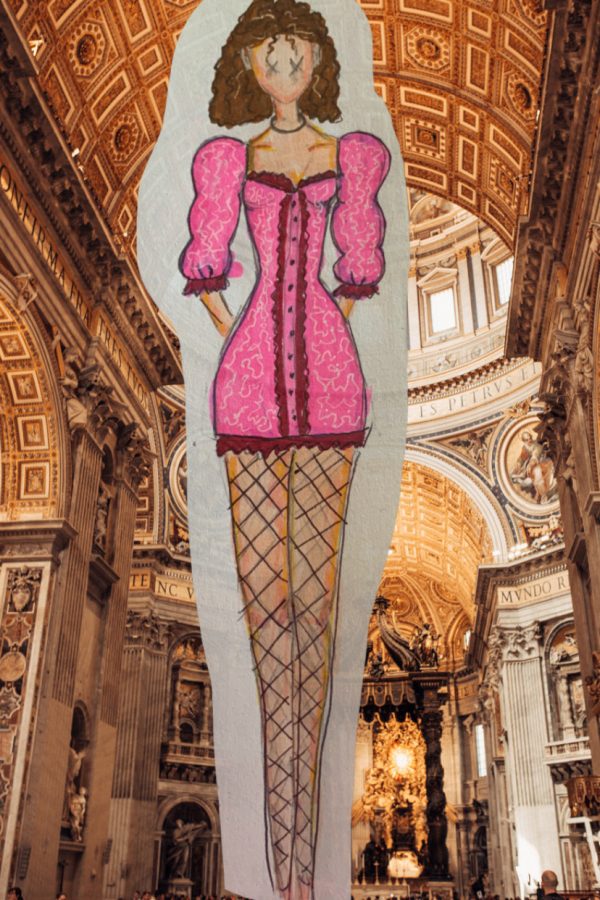Fashion students create digital portfolio to replace fashion show
Senior Lindsey Snyder had the ability to make her designs extravagant due to the digital portfolio. The lack of a budget for materials to make the clothes allowed for more creative freedom.
February 12, 2021
This year, the models showcasing fashion students’ designs will be gracing a computer screen rather than the runway.
Grady’s annual fashion show, which allows students to showcase their designs, was cancelled and replaced with a digital portfolio due to the coronavirus pandemic and time constraints. Fashion students will draw their models and garments, compiling them into a portfolio.
“There will not be a fashion show this year,” fashion teacher Kottavei Williams said. “Covid restrictions do not allow for that many people to be so close together in a building. Also, the structure of classes going from year-long to two quarters did not give enough time for fashion students to create full garments.”
The fashion show typically garners an audience of over 100 people in the old gym, where a runway is constructed. The event brings model recruiters looking for fresh faces, and ticket sales provide essential funding for the fashion program.
Seniors were disappointed that they would not have the chance to showcase their work in a fashion show. Last year’s show was also cancelled due to the pandemic.
“I wish we could have done the fashion show because I think it’s a really fun experience to get to not only design, but also make the clothes,” senior Anna-Greenfield Church said. “Since I’m a senior, I won’t get this opportunity again, so it’s really sad.”
Williams carefully crafted the portfolio replacement to allow students to showcase a variety of skills learned throughout their time in the program. All pieces were submitted digitally with the exception of the fashion doll, a doll dressed in students’ handmade clothing.
“The components of the portfolio were the designs, individual student motivation quotes, photos of the designer and a miniature fashion doll garment,” Williams said. “I wanted to at least include a full skill set, even if not lifesize.”
The project was exclusive to juniors and seniors, allowing them to showcase everything they learned throughout their three or four years in the class. About 25 upperclassmen submitted portfolios.
Now that the portfolios are complete, Williams will be uploading them to a website to allow the community to view students’ designs. Though unsure the exact date, Williams said the updated website is expected to launch sometime next week.
“It’s nice because it gives us a chance to show our work to everyone since we don’t get to do it at the fashion show,” Church said.
When the Grady administration announced that schedules for the school year would have four classes per semester rather than eight, Williams had to rethink her fashion class’ structure. Students no longer had a full year to complete their designs, but just one semester.
“The portfolio process, with all the components, critiques, research and time it took to create, took the entire two quarters,” Williams said. “Quality takes time, and I wanted to give my students the opportunity to create something they were proud of.”
In previous years, students had to purchase many of the materials they used to create their garments. This created limits to creativity as they could only create what their budget allowed.
“It was fun to be able to expand your imagination on what you wanted to do for the fashion show because materials and buying everything were no longer a factor,” senior Lindsey Snyder said. “I was able to make my designs very large and luxurious, which I probably would not have been able to do if I had to actually make the clothes because I would have had a budget in mind. I probably wouldn’t have created the same collection I did if we had done an in-person show.”
Ultimately, the lack of a need for materials made the project easier for students. Physical copies of their designs were no longer necessary, giving them more freedom to make bold, creative decisions.
“The lack of materials actually helped me by allowing me to learn how to persevere and problem solve,” junior Melanie Anderson said. “I had to find ways around not having materials, which allowed me to become more independent and creative with my decisions.”
Students were encouraged to find inspiration wherever they saw fit, giving them creative freedom. Some explored body positivity and female empowerment, while others challenged traditional religious and societal norms.
“I was really inspired by Catholicism,” Snyder said. “I just thought there were these ideas of restriction, piety and aestheticism that went along with that. They were essentially keeping women in corsets and really restrictive and conservative clothing. I wanted to make really grungy Catholic wear to subvert those ideas about Catholicism. I don’t really believe in the idea of conservatism, so my goal was to explore those ideas.”
Overall, students savored the opportunity to explore new design styles and showcase their work to the community.
“I definitely enjoyed brainstorming and the whole process of making a mood board to decide what I wanted to do,” Snyder said. “I kind of just do it on my own as a hobby, so doing it for school was a really fun thing.”







